Heritage: Care-Preservation-Management
3 total works
Changes or innovations which threaten `our heritage' arouse great hostility in those who want to preserve the past in its entirity.`The heritage' has become a commodity, a device to sell everything from biscuits to country houses. Fowler skilfully examines the present relationship between the past and the present, analysing the manner in which we mould and interpret the past to fit our current needs. He assesses the influence of our heritage in the last decade of the 20th century, and with a wide range of examples judges the consequences of the increasing pressures of the heritage industry. As well as a diagnosis of where the past is being misused, he provides prescriptions for responsible development, and a thoughtful interpretation of a common past. As well as addressing the needs of the professional involved in the heritage industry he also considers the consumer - all those who visit museums, enjoy a historic site or an art exhibition, or who simply dislike the hijacking of our common heritage by commercial or vested interests.
The effective management of the cultural heritage has become one of the most pressing needs of the 1900s. Improving standards of management depends on high standards of training for archaeologists. The needs are pressing throughout every area of the world. The World Archaeological Congress has been concerned to foster high standards of training and to understand the real training needs of each region and country. Until those needs are known and understood, intelligent and coherent action is impossible. This volume provides examples of training for archaeological and cultural resource management drawn from many regions. The authors also show what is being done to ensure higher professional standards among archaeological heritage managers, and how common standards and practices are beginning to develop. They also suggest how efforts should best be targeted for the rest of the decade.
Changes or innovations which threaten "our heritage" arouse great hostility in those who want to preserve the past in its entirety. The heritage has become a commodity, a device to sell everything from biscuits to country houses. Fowler skilfully examines the present relationship between the past and the present, analyzing the manner in which we mould and interpret the past to fit our current needs. He assesses the influence of our heritage in the last decade of the 20th century, and with a wide range of examples judges the consequences of the increasing pressures of the heritage industry. As well as a diagnosis of where the past is being misused, he provides prescriptions for responsible development, and a thoughtful interpretation of a common past. As well as addressing the needs of the professional involved in the heritage industry he also considers the consumer - all those who visit museums, enjoy a historic site or an art exhibition, or who simply dislike the hijacking of our common heritage by commercial or vested interests.
This book should be of interest to professionals in the fields of museology, heritage and leisure management, together with students in heritage studies and archaeology.
This book should be of interest to professionals in the fields of museology, heritage and leisure management, together with students in heritage studies and archaeology.


